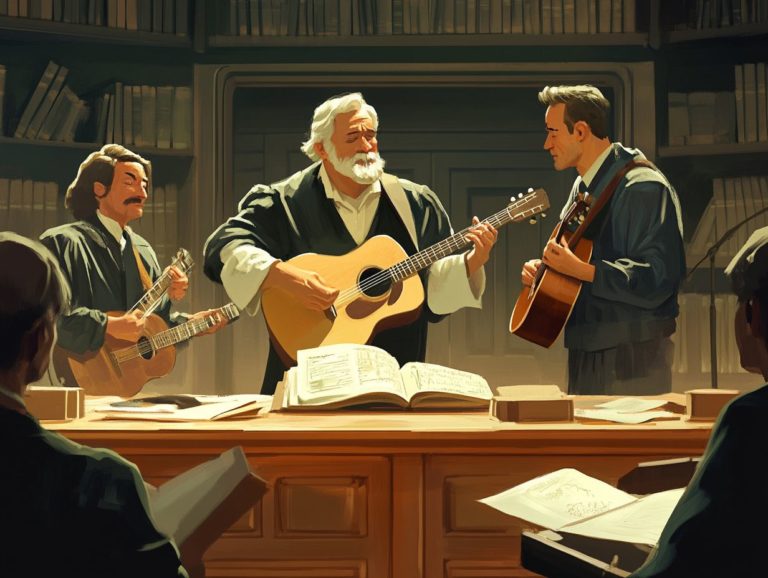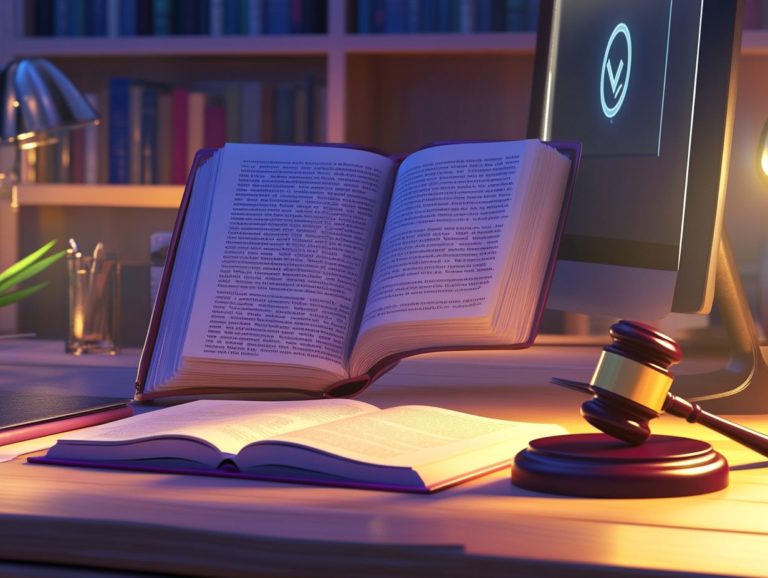The Evolution of Copyright Law Over the Decades
Copyright law has undergone a remarkable evolution over the years, fundamentally influencing how creative works are protected and shared.
This article delves into the historical journey of copyright law, emphasizing its critical role in safeguarding intellectual property. As technology progresses, fresh challenges emerge, necessitating adaptations within legal frameworks.
Contemporary controversies and recent cases ignite lively debates, prompting reflection on the future of copyright law in our rapidly shifting digital landscape.
Join us in exploring this fascinating journey of copyright law!
Contents
- Key Takeaways:
- The History of Copyright Law
- The Purpose and Function of Copyright Law
- Protecting Intellectual Property
- The Impact of Technological Advancements
- Challenges and Adaptations
- Current Copyright Laws and Controversies
- Recent Cases and Debates
- The Future of Copyright Law
- Frequently Asked Questions
- What is copyright law and how has it evolved over the decades?
- When was the first copyright law established and how did it differ from modern laws?
- How has the digital age impacted copyright law?
- What are some major milestones in the evolution of copyright law over the decades?
- How have international copyright laws changed over the decades?
- What challenges does the future hold for copyright law?
Key Takeaways:

Copyright law has evolved significantly over the decades, with origins dating back to the 18th century. Major changes and amendments have occurred throughout history. The primary purpose of copyright law is to protect intellectual property and incentivize creativity, but it has faced challenges and adaptations with the rise of technology. For a deeper understanding, you can explore the history of copyright law. Recent cases and debates have highlighted the controversies surrounding current copyright laws. The future holds potential changes to continue protecting intellectual property in the digital age.
The History of Copyright Law
The history of copyright law unfolds as a captivating journey, starting with the early privileges bestowed upon authors and printers. It traces its roots back to the Statute of Anne in 1710, a landmark moment that laid the groundwork for copyright principles aimed at safeguarding original works, and reflects the broader themes discussed in the evolution of IP litigation over the decades.
Since then, it has evolved into modern regulations granting authors exclusive rights over their creations while thoughtfully addressing their moral rights (the right to attribution and integrity of authorship).
This delicate balance also reflects the cultural effects of copyright laws on the public domain and the publishing industry, showcasing a dynamic interplay between creativity and protection.
Origins and Early Developments
The origins of copyright law trace back to early privileges granted to authors and printers, with the Statute of Anne serving as a pivotal moment in the protection of authorship and the regulation of the printing press.
This landmark legislation, enacted in 1710, acknowledged authors’ rights to control their works and set the stage for a more organized publishing environment.
By granting exclusive rights for a specific period, it aimed to curb unauthorized reproduction of literary works.
The Stationers Company, established in 1557, played a crucial role in enforcing copyright laws, ensuring authors received the recognition and compensation they deserve for their creations.
This framework cultivated a culture of innovation among writers and printers, transforming the literary landscape and laying the groundwork for the modern principles of copyright.
Major Changes and Amendments
Significant changes and amendments to copyright law have shaped its current framework, including the evolution of licensing agreements over the years, introducing essential legal protections for moral rights, extending copyright terms, and defining exceptions that balance the interests of authors, publishers, and the public.
Landmark statutes like the Copyright Act of 1976 in the United States laid a stronger foundation for creators’ rights. In the years that followed, updates such as the Digital Millennium Copyright Act (DMCA) and the Copyright Term Extension Act have profoundly influenced the perception of moral rights, underscoring the importance of protecting an author’s integrity and attribution amid rapid technological advancements.
Copyright exceptions like fair use play a crucial role in facilitating educational and transformative uses of copyrighted material, fostering a vibrant culture of creativity while ensuring original creators receive due recognition.
The Purpose and Function of Copyright Law
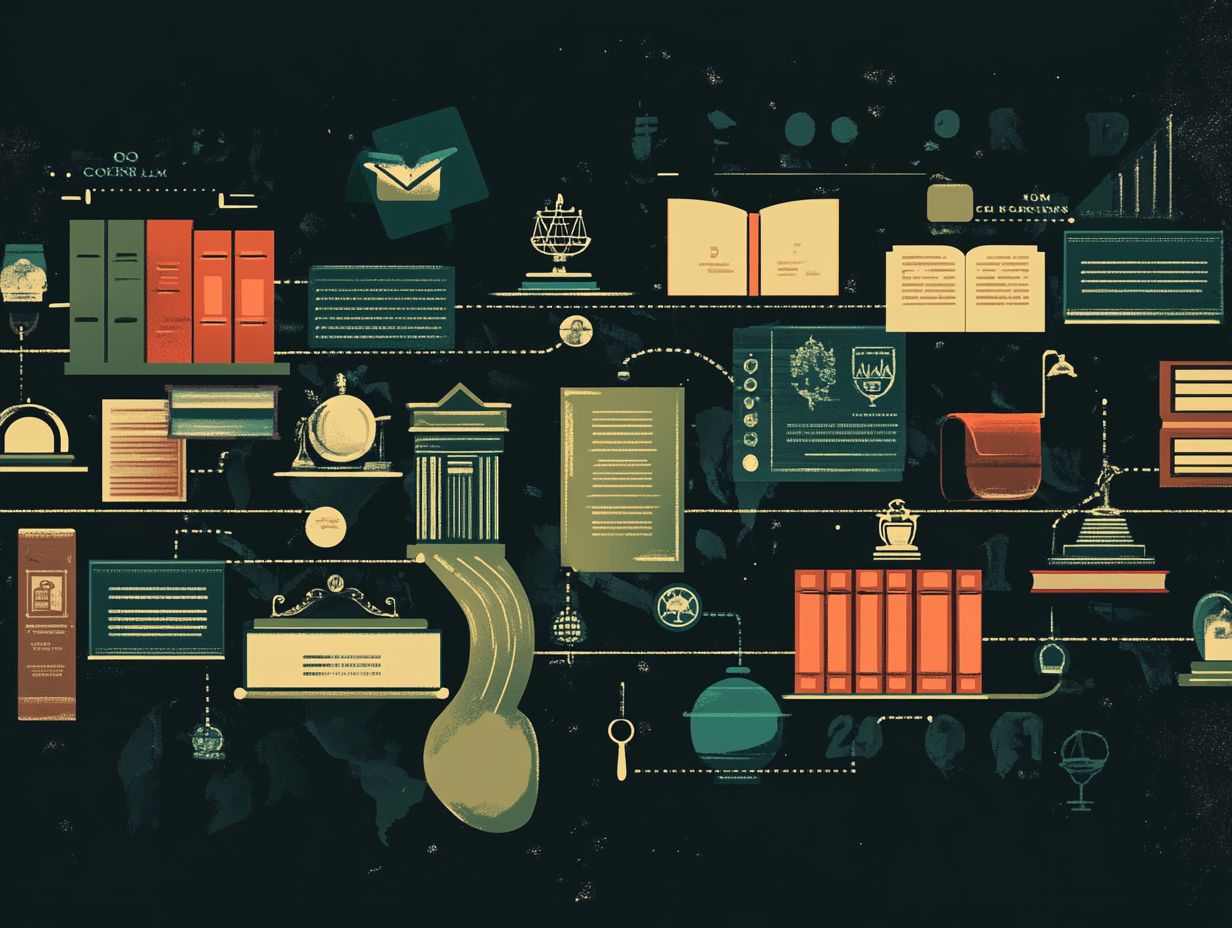
The essence of copyright law lies in its commitment to safeguarding the intellectual property rights of authors and creators. It grants them exclusive control over their original works, allowing creativity to thrive.
In doing so, copyright law plays a vital role in preserving our cultural heritage for future generations.
Protecting Intellectual Property
Protecting intellectual property is a cornerstone of copyright law. It offers you legal protection and exclusive rights as a creator.
This ensures that your works are shielded from unauthorized use and copyright infringement. The law allows you to control how your creations are reproduced and distributed.
By benefiting from your hard work, the law fosters artistic expression and technological advancement. The consequences can be severe often leading to legal action and financial penalties for those who dare to exploit someone else’s work without permission.
That s why it s crucial for you to understand and adhere to copyright protections. Doing so not only safeguards your creations but also upholds the integrity of creative industries, promoting a vibrant exchange of ideas and concepts.
The Impact of Technological Advancements
Technological advancements have profoundly influenced copyright law, ushering in a host of digital copyright challenges. You ll find that these developments not only complicate copyright enforcement but also reshape the exceptions to copyright that must now take the digital landscape and creators’ rights into account.
Challenges and Adaptations
Challenges and adaptations in copyright law are continuously emerging as the digital landscape evolves, sparking lively debates and necessitating updates to enforcement strategies aimed at better safeguarding creators in the digital age.
As streaming platforms and social media transform the way content is shared and consumed, you may have to navigate the complexities of unauthorized use of your creations. The rapid pace of technological innovation leaves many traditional copyright principles struggling to keep pace, raising pertinent questions about what truly constitutes fair use in this new environment.
Enforcing copyright laws has become more complicated, often demanding significant resources that many individual creators and small businesses simply don t possess.
To tackle these challenges, stakeholders are actively exploring innovative solutions, such as adopting more flexible licensing models and enhancing educational programs to cultivate a deeper understanding of copyright rights and responsibilities among users.
Current Copyright Laws and Controversies
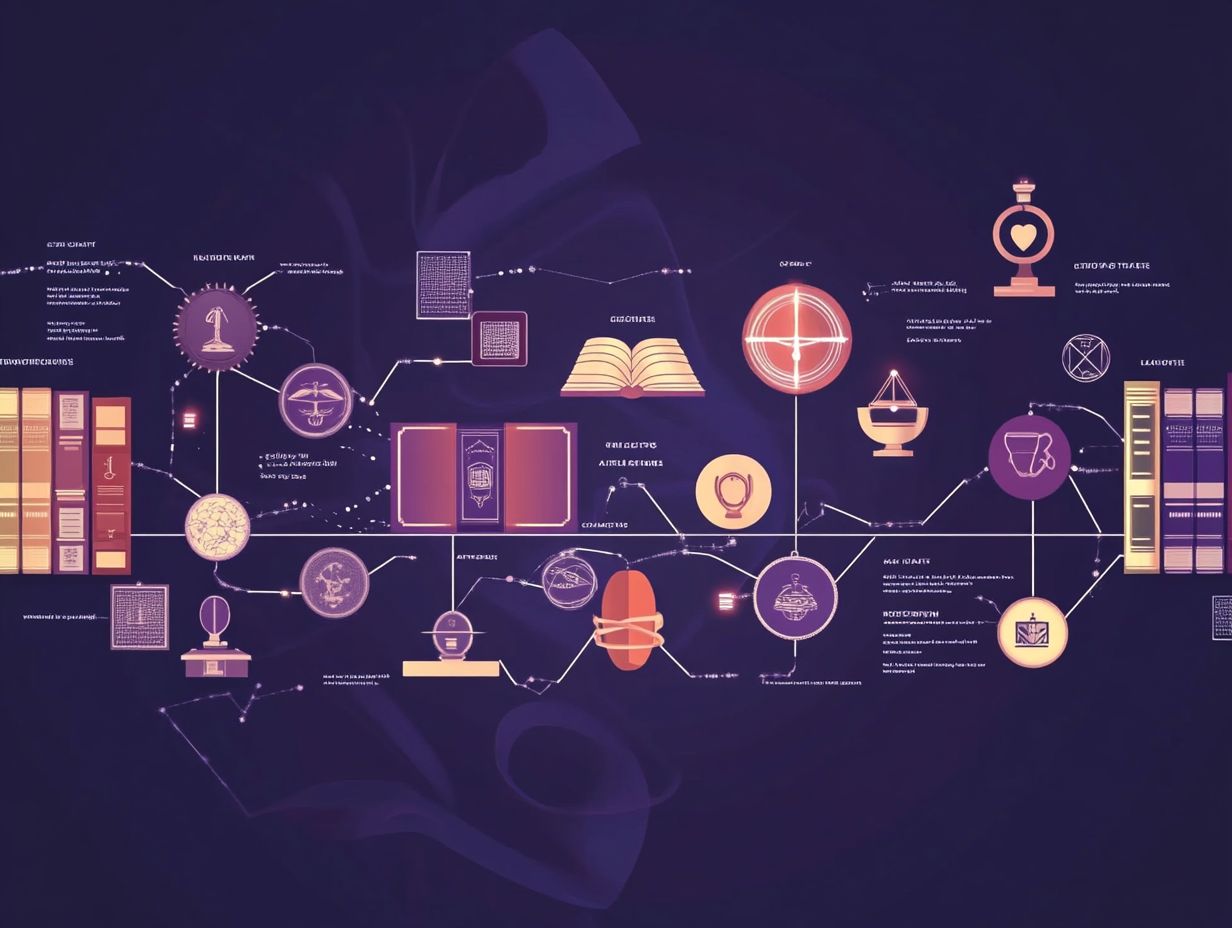
Current copyright laws frequently find themselves at the heart of controversies and vigorous debates.
You may encounter discussions surrounding copyright infringement, the sufficiency of copyright protections, and the pressing need for reform to tackle the challenges that both creators and consumers face.
Recent Cases and Debates
Recent copyright cases have sparked vibrant discussions about copyright infringement, illuminating the intricate nuances of legal recognition and the ongoing debates surrounding copyright reform to better align with modern creative practices.
These cases, ranging from high-profile disputes involving major entertainment figures to the struggles of independent creators, highlight the tension between traditional copyright laws and the swift evolution of digital media.
As you navigate the delicate boundary between inspiration and imitation, the outcomes of these legal battles prompt essential questions about ownership and fair use.
Many advocates contend that the existing framework often stifles innovation and inadequately protects creators rights in the digital landscape, fueling renewed calls for reform.
By unpacking the implications of these landmark rulings, stakeholders aim to cultivate a more balanced environment that benefits both creators and consumers alike.
The Future of Copyright Law
The future of copyright law is on the brink of substantial evolution. As digital copyright challenges escalate, we must urgently adapt copyright protections to match the realities of today’s creative landscape, much like the evolution of patent law over the last decade.
It s essential to adapt protections that truly reflect the realities of today s creative industries.
Predictions and Potential Changes
Predictions for copyright law indicate a shift toward more comprehensive reforms and stronger digital protections. These changes aim to enhance legal recognition for creators in today s rapidly evolving digital landscape.
Technology is advancing rapidly, and digital content has become a staple in daily life. It s crucial for legislation to keep pace with these changes. Future reforms may focus on safeguarding original works shared online, effectively tackling the challenges of unauthorized copying and distribution.
With enhanced legal frameworks, you could benefit from clearer guidelines on fair use. This would allow you to utilize existing works while ensuring that your own creations remain protected. Improved enforcement mechanisms could empower you, as an artist, musician, or writer, to defend your ideas and creations against infringement. Exciting changes are on the horizon that could nurture an environment inspiring creativity and innovation in the digital age.
Frequently Asked Questions
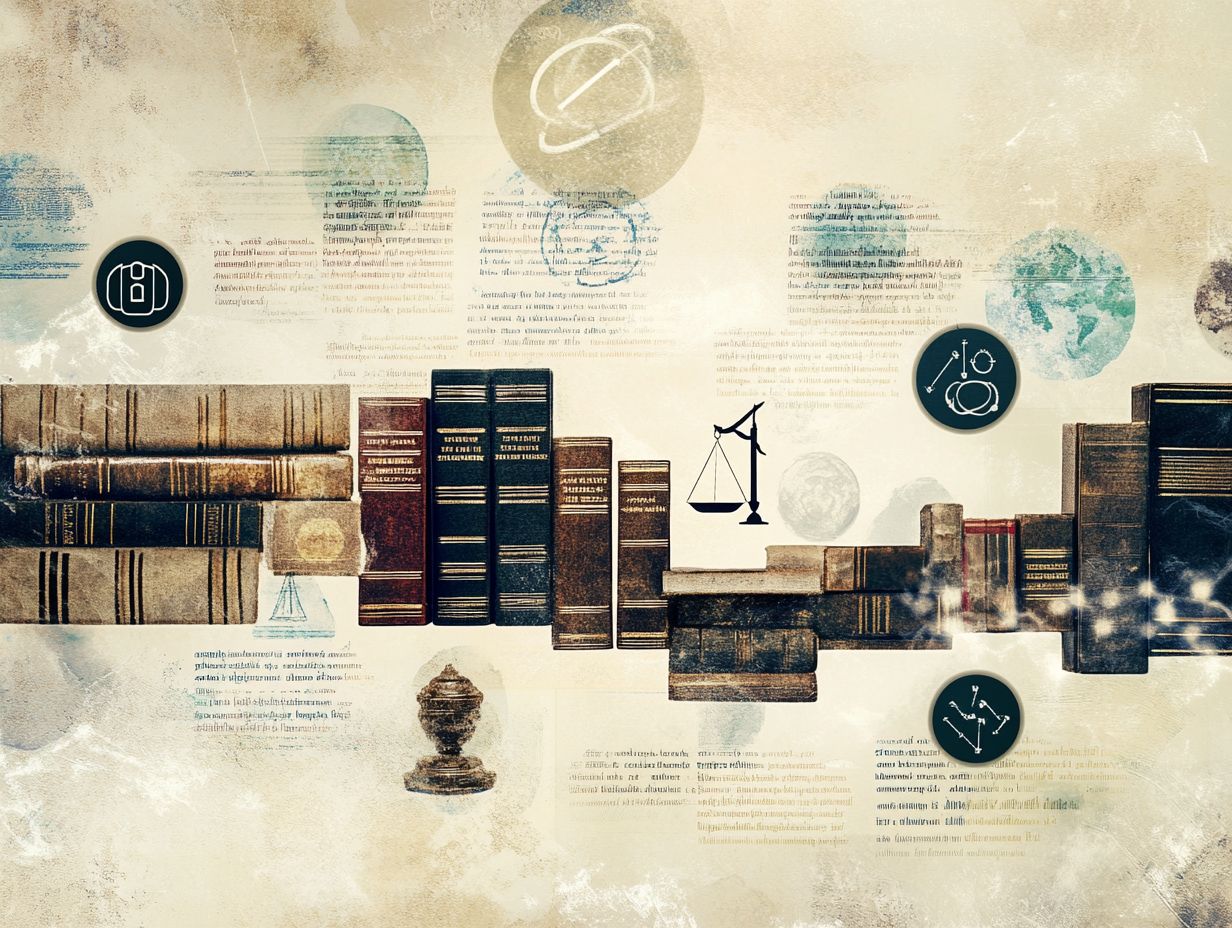
What is copyright law and how has it evolved over the decades?
Copyright law is a legal concept that grants creators and owners of original works the exclusive right to reproduce, distribute, and display their work. Over the decades, copyright law has undergone significant changes to keep up with advancements in technology and address new forms of creative expression.
For example, the rise of digital media has prompted new legal frameworks to protect creators in the online space.
When was the first copyright law established and how did it differ from modern laws?
The first copyright law was established in England in 1710, known as the Statute of Anne. It granted authors the exclusive right to publish their work for 14 years, with an option to renew for another 14 years.
This differed greatly from modern laws, which provide much longer periods of protection and cover a wider range of creative works.
How has the digital age impacted copyright law?
The digital age has transformed copyright law, making it easier to reproduce and distribute creative works. This evolution has led to the development of new laws, such as the Digital Millennium Copyright Act (DMCA), which addresses copyright infringement on the internet.
What are some major milestones in the evolution of copyright law over the decades?
Major milestones in copyright law include the Berne Convention in 1886, the Copyright Act of 1976, the WIPO Copyright Treaty in 1996, and the Digital Millennium Copyright Act in 1998.
These laws have helped modernize copyright provisions to adapt to new forms of creativity and technology.
How have international copyright laws changed over the decades?
There have been significant efforts to harmonize copyright laws internationally. The Berne Convention of 1886 was an early step, and today, many countries have signed onto international copyright treaties. These treaties help ensure consistent protection for creators around the world.
What challenges does the future hold for copyright law?
The future holds many challenges for copyright law, as technology continues to evolve and new forms of creativity emerge. One challenge is finding a balance between protecting creators’ rights and promoting access to information. Additionally, issues of copyright infringement on the internet and in the global marketplace require ongoing attention.


